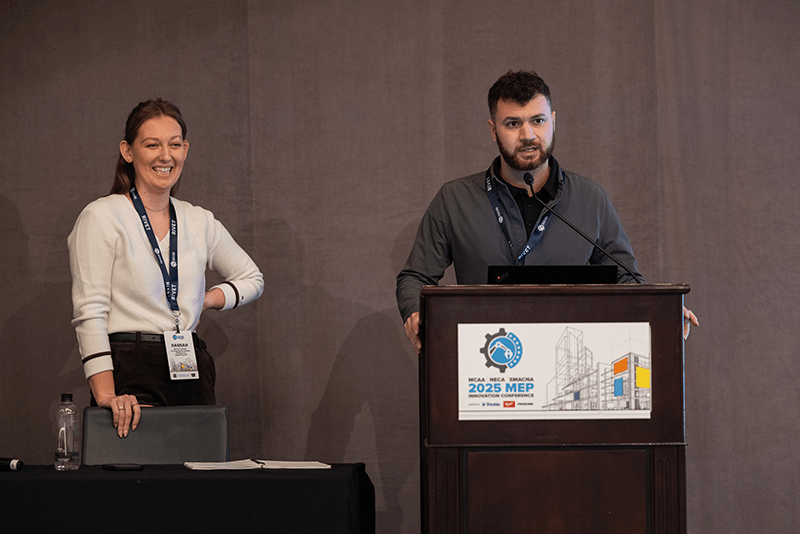Hannah Thomazin (Risk Analyst, U.S. Engineering Holdings) and Aristotle Vrohidis (Senior Project Controls Manager, U.S. Engineering Construction) shared practical insights on tracking labor productivity at the 2025 MEP Innovation Conference. Held from January 27-30, the MEP Innovation Conference was an industry event that works to advance technology and best practices in mechanical, electrical, and plumbing (MEP) construction.

Organized by the Mechanical Contractors Association of America (MCAA), the National Electrical Contractors Association of America (NECA), and the Sheet Metal and Air Conditioning Contractors National Association (SMACNA), the conference brings together professionals across the industry to share expertise and shape the future of MEP construction.
As leaders in workforce planning and data-driven tracking, Vrohidis and Thomazin talked about how our team is refining labor tracking methods to improve project efficiency.
Tackling Industry Challenges
Vrohidis and Thomazin’s session, Understanding Labor Productivity, provided attendees with a closer look at U.S. Engineering’s approach to earned installed hours tracking – offering a structured, data-driven method for workforce planning.
Accurately tracking labor productivity has been a consistent challenge in the industry, with disparities in data collection and forecasting impacting project planning. Vrohidis and Thomazin addressed these hurdles by outlining how U.S. Engineering refines its labor tracking approach to improve accuracy and streamline project outcomes.
“The concept of tracking productivity isn’t new,” said Vrohidis. “But the way we’re refining it – through collaboration between project teams, virtual construction, and application development – helps ensure its effectiveness.”
Their presentation started valuable conversations, leading to an extended post session Q&A.
“For an hour after our session, we had a line of people wanting to talk to us,” said Vrohidis. “It showed how relevant these conversations are for the industry.”
Leveraging Data
ineering’s model-based approach delivers real-time, measurable insights that enable teams to make more informed decisions.

“This approach ensures that we’re making decisions based on actual progress rather than estimates,” said Thomazin. “When labor data is tracked at a granular level, it reduces risk and improves project efficiency.”
By leveraging digital modeling, project teams can monitor trends, analyze performance, and forecast costs with strong confidence. This approach aligns with the industry’s broader movement toward operational efficiency and informed decision-making.
A Platform for Leadership and Knowledge Sharing
The conference not only provided a stage for Vrohidis and Thomazin to share their expertise, but also reinforced U.S. Engineering’s role in shaping industry conversations.
“Many companies are still figuring out how to implement this kind of tracking,” said Thomazin. “It’s clear that there’s strong interest in moving in this direction.”
But success in labor tracking isn’t just about adopting new methods – it requires the right team and tools.
“It’s not just one person pushing this forward – it’s a team effort across departments. Having the right technology and people in place makes all the difference,” said Vrohidis.
The Work Behind the Expertise
ming an industry leader. Both have been instrumental in refining U.S. Engineering’s data driven approach, making them natural thought leaders in the space.

“I always remind myself that I’m simply sharing what I already know,” said Vrohidis. “The key is to focus on the main ideas and let the conversation flow naturally.”
For Thomazin, who was selected for the MCAA Innovative Technologies Committee, the conference was an opportunity to sharpen her skills.
“I write down key points by hand multiple times before speaking. It helps me internalize the material in a way that feels natural,” said Thomazin. “Beyond that, I try to engage with the audience and adapt based on their reactions.”
Through active participation and knowledge sharing, U.S. Engineering continues to play a key role in the evolution of MEP construction. Their contributions at the conference reflect a commitment to innovation, efficiency, and collaboration – elements that will influence industry standards for years to come.